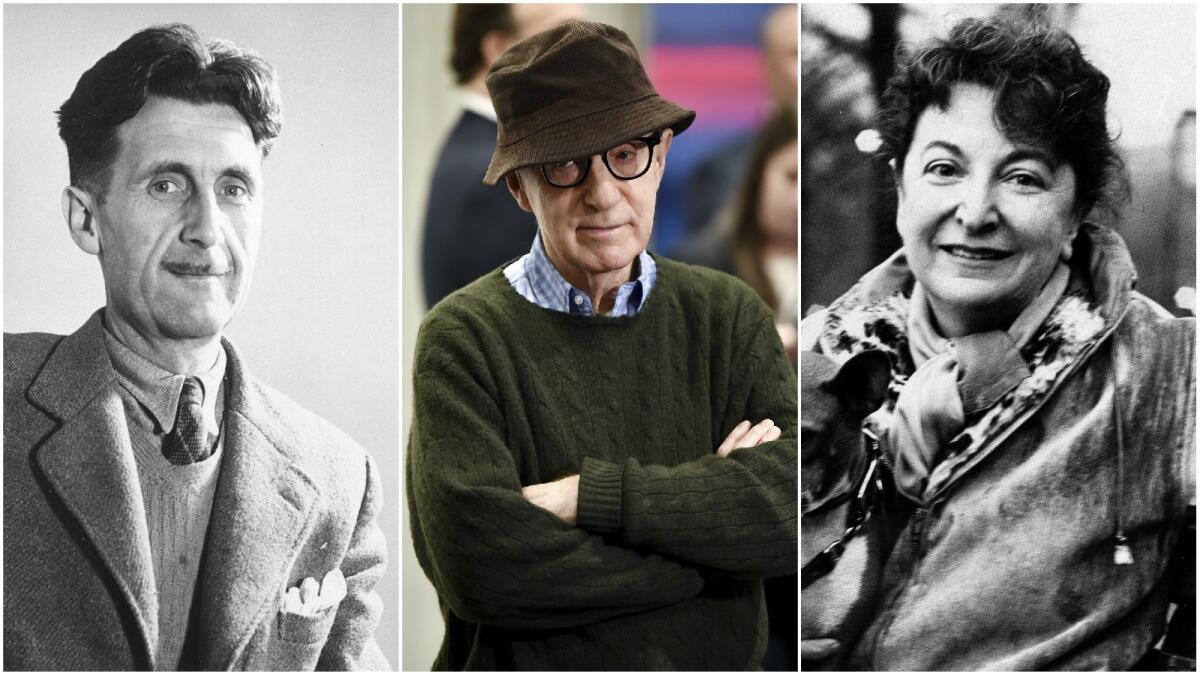Critic’s Notebook: As artists fall into disgrace, must their art be consigned to oblivion?

- Share via
The other day, while paging through a collection of George Orwell’s writing, I was startled by his angry dismissal of fellow writers Stephen Spender and W.H. Auden as “fashionable pansies.” I shrugged my shoulders and kept on reading.
I had a similar reaction about a year ago when, leafing through a collection of early Pauline Kael film criticism, I happened upon a negative review of the screen version of Lillian Hellman’s “The Children’s Hour.” Kael complains that “the lesbianism is all in the mind” before making this doozy of a parenthetical quip: “I always thought this was why lesbians needed sympathy — that there isn’t much they can do.”
These little homophobic nuggets didn’t change my thinking about these great writers, who have too much intelligence and flair to be reduced to their worst statements. I don’t expect artists and critics from the past to be exemplary in ways that meet my 21st century standards, and I hope that generations to come will look upon this era with some tolerance for our blind spots.
Everyone these days seems to be morally inflamed. There’s certainly no shortage of reasons. A thrilling movement has taken root against sexual harassment and misconduct that is inspiring hope for overdue reform in the entertainment industry and beyond.
The cavalier way men have systemically abused their power over women in and around the workplace warrants little leniency. But a more slippery question has emerged in this me-too moment of cultural reckoning: What to do with the works of artists whose conduct has been abhorrent?
In the growing gallery of alleged predators, there aren’t any artists I hold dear. James Toback’s films aren’t in my Netflix queue. I never mistook Kevin Spacey for one of the greats. And my admiration for James Levine’s conducting has been mostly of the dilettantish variety.
But inevitably a contemporary artist with whom I feel a special kinship will shatter my illusions about his or her character. I doubt that I will throw away the books or delete the recordings or swear off the films. I’m sure I’ll be disillusioned and quite possibly disgusted, but I know that an artist is not identical with his or her masterpieces and that few human beings can live up to their greatest achievements.
This is a theme that Marcel Proust returns to in his epic novel, “In Search of Lost Time” (more romantically known in English as “Remembrance of Things Past”). The narrator recalls a dinner party in which, as a young man, he meets his hero, the writer Bergotte. The young Marcel, intimidated to be seated among the important guests of the swanky Swanns, is struck immediately by the way Bergotte bears no physical resemblance to the man he had “slowly and painstakingly constructed … a drop at a time, like a stalactite, out of the limpid beauty of his books.”
More distressing to Marcel than Bergotte’s coarse appearance is “the busy and self-satisfied mentality … which had nothing in common with the type of mind that informed the books.” The narrator, a natural philosopher, begins to understand through this encounter that art is not contingent on the specific circumstances of an artist’s life.
The creative capacity to transform experience into a reflecting mirror for others is the miracle. This gift is separate from the qualities that distinguish a person in society and help open the doors to a career.
As for the wicked rumors dogging Bergotte, the talk of a “semi-incestuous affair, allegedly further complicated by some indelicacy about money,” Marcel conjectures that it “may only be in a life deeply steeped in its vice that the moral question can arise with the full power of its anxiety.” For Proust, the artist answers this question “not on the plane of his individual life, but in the mode of existence that represents his true life; and there the answer given is a literary one, of general application.”
If a book or play speaks, it does so in a way that transcends the limitations, and imperfections of the author, a more elusive figure than the publishing industry (and identity politics hard-liners) would have us believe. I’m not so much of the school of literary critic Roland Barthes, who famously declared the death of the author, as of the school of Proust, who saw that a writer crystallizes the notion of a multiplicity of identities, the way each of us contains numerous selves, not all of them readily categorizable.
Anyone whose occupation is imagining the lives of others necessarily has a thronging inner world. The artist who creates beauty can contain a fair amount of ugliness. I was reminded of this point recently when attending the Getty exhibit of my favorite Italian painter, Caravaggio, a revolutionary artist with a thuggish reputation who is thought to have murdered a man in a botched castration incited by a dispute over a favored prostitute.
Speaking of gory homicides, Ben Jonson, a playwright second only to Shakespeare in the Elizabethan-Jacobean era, killed an actor in a duel and was arrested. This detail of his biography, however, hasn’t much impeded audiences’ enjoyment of his classic comedies “The Alchemist” and “Volpone.” Jonson, of course, is not simply the slayer of a fellow theatrical. He is also the self-taught playwright of prodigious classical learning, Shakespeare’s champion and a heck of a funny farceur.
History is the ultimate arbiter of what endures. Moral verdicts on the author, the raison d’être of many biographies, is a secondary layer that can color the reception of an artist’s oeuvre but cannot nullify work that retains its expressive power. Even the plays of mad, misogynistic August Strindberg are performed regularly today, with the groundbreaking “Miss Julie” seemingly in constant rotation.
Disgraced living artists raise stickier concerns. Should, for example, actors stop performing in Woody Allen’s films after the allegations made by Dylan Farrow? Hollywood consciences (an oxymoron if ever there was one!) have already been tested, though the casting invitations have lost a good deal of their luster after the scandals and string of subpar movies.
But what about Allen’s best work? I can’t imagine watching “Manhattan” anytime soon. The sight of Allen slobbering over Mariel Hemingway was queasy-making before all the talk of his predilection for young girls. But am I ready to reject “Annie Hall,” “Broadway Danny Rose” and “Hannah and Her Sisters”? Not yet. There are too many indelible performances, including several by Mia Farrow, Dylan’s devoted mother, that would have to be sacrificed. Perhaps then it’s a good thing that the longevity of Allen’s movies will be determined by future generations of cinephiles rather than the filmmaker’s off-screen culpability.
This is a separate issue from, say, what to do with the statues of Confederate generals. Following the lead of my colleague Christopher Knight, I’d like to see these monuments, which (generally speaking) are of no particular artistic merit, removed and placed in historical exhibits where they can be contextualized and quarantined. I might feel differently if they were wrought by someone on the level of Michelangelo or Giacometti (a hypothetical that tempts an LOL emoticon), but then I’m unabashedly an apologist for superlative art, which renews reality by rejecting propaganda and cliches.
Working artists who have fouled their reputations will have to fend for themselves. Directors who have taken advantage of the casting couch, actors who have grotesquely exploited their stardom, conductors who have preyed on their young charges deserve to have the rug pulled out from under them. If the work they’ve done lives on, it will do so apart from the memory of their shameful deeds. This will take time.
Some of the shock we’re experiencing right now about all these fallen idols stems from our mythologizing natures. We expect our heroes to be exemplary, yet (as Proust points out) human fallibility may be a necessary ingredient in creativity. Heinous crimes are another matter entirely, but as any reader of biography can attest, genius and pathology aren’t exactly strangers.
I’ll admit that I’m as contemptuous as the next hanging judge on Twitter when I read about the inappropriate conduct of the rich and famous in their five-star-hotel bathrobes. The great majority of these men are getting exactly what they deserve. But like many who feel a pang of obligation to due process, I can’t help wondering if in the collective rush to right historical wrongs we aren’t in danger of losing sight of other values.
Justice, as symbolized by the scales, is an art of delicate calibration. But watershed movements aren’t subtle. They can’t afford to be. Any loss of momentum threatens a reversion to an unacceptable status quo. Ambiguity must wait out the revolution. But as the tectonic plates of society shift and a more egalitarian era beckons, we must continue to stand guard against the rigidity of thinking that breeds its own climate of intolerance. History is a muddle because human nature has yet to work out its kinks.
Language maps our unsteady progress. I’m glad Orwell’s use of “pansies” didn’t prevent me from reading on, because in another anthology of his work I came across a letter in which he explains to Spender, with whom he’s struck up a correspondence, that though he has said some unkind things about him in the press, he couldn’t help changing his mind once he met him in person, “because when you meet anyone in the flesh you realise immediately that he is a human being & not a sort of caricature embodying certain ideas.”
As for Kael, after shuddering over her outrageous remarks in her early reviews, I began to see that her fearless candor, while not fully under control at this point, was what made her such a sharp critic. Her political incorrectness hasn’t aged well, but her directness is what has kept her writing compulsively readable.
For those having difficulty drawing distinctions, let me state categorically that I have no interest in furthering the careers of rapists, predators, racists and homophobes. But if evidence turns up that Shakespeare was a sadistic creep, I trust that we will still appreciate “Hamlet,” “King Lear” and “The Tempest.” And the same should hold for the work of our less illustrious contemporary artists, whose virtue may fall egregiously short of the gifts they’ve bestowed.
SIGN UP for the free Essential Arts & Culture newsletter »
Follow me @charlesmcnulty
More to Read
The biggest entertainment stories
Get our big stories about Hollywood, film, television, music, arts, culture and more right in your inbox as soon as they publish.
You may occasionally receive promotional content from the Los Angeles Times.











